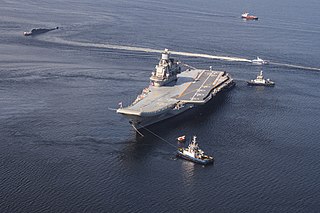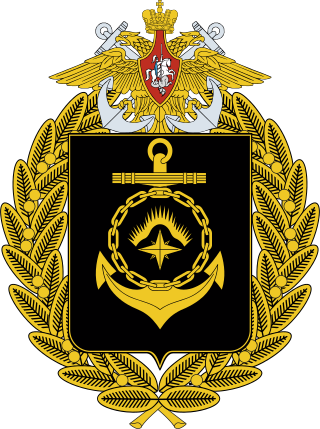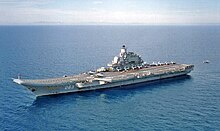
A cruiser is a type of warship. Modern cruisers are generally the largest ships in a fleet after aircraft carriers and amphibious assault ships, and can usually perform several operational roles from search-and-destroy to ocean escort to sea denial.

Admiral Flota Sovetskogo Soyuza Kuznetsov is an aircraft carrier serving as the flagship of the Russian Navy. It was built by the Black Sea Shipyard, the sole manufacturer of Soviet aircraft carriers, in Nikolayev within the Ukrainian Soviet Socialist Republic and launched in 1985, becoming fully operational in the Russian Navy in 1995. The initial name of the ship was Riga; it was launched as Leonid Brezhnev, embarked on sea trials as Tbilisi, and was finally named Admiral Flota Sovetskogo Soyuza Kuznetsov after Admiral of the Fleet of the Soviet Union Nikolay Gerasimovich Kuznetsov.

The Kuznetsov-class aircraft carrying cruiser, Soviet designation Project 1143.5, is a class of STOBAR aircraft carriers operated by the Russian and Chinese navies. Originally designed for the Soviet Navy, the Kuznetsov-class ships use a ski-jump to launch high-performance jet aircraft and arrestor gears for landing. The design represented a major advance in Soviet fleet aviation over the Kiev-class carriers, which do not have full-length flight deck and could only launch VSTOL aircraft. The Soviet Union's classification for the class was as a heavy aircraft-carrying cruiser, which permits the ships to transit the Turkish Straits without violating the Montreux Convention. However, the Chinese variants are classified as aircraft carriers.

The Kirov class, Soviet designation Project 1144 Orlan, is a class of nuclear-powered guided-missile battlecruisers of the Soviet Navy and Russian Navy, the largest and heaviest surface combatant warships in operation in the world. Among modern warships, they are second in size only to large aircraft carriers, and of similar size to a World War I-era battleship. The ships are often referred to as battlecruisers by Western defence commentators due to their size and general appearance. The Soviet classification of the ship-type is "heavy nuclear-powered guided-missile cruiser".

The Russian navy is the naval arm of the Russian Armed Forces. It has existed in various forms since 1696; its present iteration was formed in January 1992 when it succeeded the Navy of the Commonwealth of Independent States.
The P-700 Granit is a Soviet and Russian naval anti-ship cruise missile. Its GRAU designation is 3M45, its NATO reporting name SS-N-19 Shipwreck. It comes in surface-to-surface and submarine-launched variants, and can also be used against ground targets.

Soviet Naval Aviation was the naval aviation arm of the Soviet Navy.

The Northern Fleet is the fleet of the Russian Navy in the Arctic.

Kirov is the lead ship of the Kirov class of nuclear-powered guided missile cruisers. Originally built for the Soviet Navy and passed onto the succeeding Russian Navy, she and her three sister ships are the largest and heaviest surface combatant warships built by them. The Soviet classification of the ship-type is "heavy nuclear-powered guided missile cruiser", nonetheless Kirov's size and weapons complement have earned her the unofficial designation of a battlecruiser throughout much of the world, as her size and displacement is similar to a typical World War I battleship. The appearance of the Kirov class was a significant factor in the U.S. Navy recommissioning the Iowa class. She was named after a Project 26 cruiser.

Pyotr Velikiy is the fourth Kirov-class battlecruiser of the Russian Navy. She was initially named Yuri Andropov after Yuri Andropov, the former General Secretary of the Communist Party, but the ship's name was changed after the fall of the Soviet Union. The Russian designation for the type is "heavy nuclear missile cruiser", but Western defense commentators have resurrected the term "battlecruiser" to describe them, as they are the largest surface "line of battle" warships in the world. Pyotr Velikiy is the flagship of the Northern Fleet.

The Russian cruiser Marshal Ustinov, is a Slava-class cruiser of the Russian Navy. The Russian name for the ship type is Raketnyy Kreyser (RKR), meaning "Missile Cruiser". The ship is named after Dmitriy Ustinov, a former Soviet Minister of Defence. Marshal Ustinov was assigned to the 43rd Missile Ship Division of the Russian Northern Fleet, whose homeport is in Severomorsk. From 2012 to 2016, the cruiser underwent a major overhaul. The vessel returned to service in 2017 and has since been deployed to the Mediterranean Sea.

Admiral Nakhimov is the third battlecruiser of the Russian Navy's Kirov class. The ship was originally commissioned into service with the Soviet Navy in 1988, known back then as Kalinin (Калинин), a name the ship kept until 1992 when it was renamed for Pavel Nakhimov. From 1997 Admiral Nakhimov is undergoing a repair and a refit to receive new and improved weaponry and had been scheduled to re-enter service with the Russian Navy in around 2022. The date for the ship's return to service is uncertain. In 2021 it was reported that the ship's return to service would be delayed until "at least" 2023 while in February 2022 it was reported that Sevmash CEO Mikhail Budnichenko noted that the warship was planned for delivery in 2022. Later in the year it was again reported that the vessel's return to service might be delayed as late as 2024, with this being eventually confirmed by the head of United Shipbuilding Corporation Alexei Rakhmanov.

Admiral Lazarev was the second Kirov-class battlecruiser. Until 1992 she was named Frunze after a Project 68 cruiser ; at that time she was renamed after Russian rear admiral Mikhail Petrovich Lazarev. Scrapping of the ship began in April 2021.

The aircraft cruiser is a warship that combines the features of the aircraft carrier and a surface warship such as a cruiser or battleship.

Kronstadt was a Project 1134A Kresta II-class cruiser of the Soviet Navy, named for the Kronstadt naval base. The first ship of her class, the ship served during the Cold War, from 1969 to 1991. She served with the Northern Fleet, with her shakedown cruise being through the Mediterranean Sea. After colliding with a destroyer in 1975, she spent five years being repaired and modernized. She was decommissioned in 1991 before being sold for scrap two years later due to reduced naval funding and deteriorating conditions.
Four ships of the Imperial Russian Navy, Soviet Navy and Russian Navy have been named after Admiral Mikhail Petrovich Lazarev.

Admiral Makarov was a Project 1134A Berkut A class cruiser of the Soviet Navy and briefly of the Russian Navy. The fourth ship of her class, the ship served mostly during the Cold War, from 1972 to 1992. She served with the Northern Fleet for the duration of her career, often operating in the Atlantic and the Mediterranean in order to show the flag, and was refitted between 1983 and 1985. She was decommissioned in 1992 due to deteriorating conditions which reduced naval funding prevented from being addressed before being sold for scrap in 1994.

Vladimir Lvovich Kasatonov is an officer of the Russian Navy. He currently holds the rank of admiral, and since 2019 has served as deputy commander in chief of the navy.

















